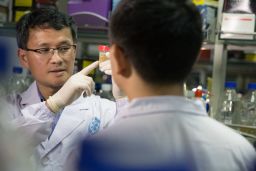Editor’s Note: Kristie Lu Stout is the host of “On China,” a talk show on CNN International. This month’s episode explores China’s scientific discoveries.
Story highlights
China has surpassed Europe in investment in scientific research and development
Chinese research has led to a blood test to detect cancer and to the creation of stem cells from urine
The future of regenerative medicine may be in your toilet, according to cutting-edge research in China.
In a lab at the Guangzhou Institute of Biomedicine and Health, research scientist Pei Duanqing has created stem cells from urine, a breakthrough that could help develop treatments for Parkinson’s and other degenerative diseases.
“We were able to purify live cells from human urine and then reprogram them back in time, to the time when fertilization took place,” Pei said. “That’s the stage when the cell has the potential to regenerate all cells in our body. … We should be able to generate the cells we need in the future, to build new tissues and organs.”
Two decades ago, Dennis Lo, director of the Li Ka Shing Institute of Health Sciences, discovered that fetal DNA exists in a mother’s bloodstream. He developed a noninvasive prenatal blood test for Down syndrome that is now available in more than 90 countries.
Today, Lo is working on a similar blood test for cancer.

“If we can sequence a baby’s genome by looking into the blood of its mother, maybe we can sequence the cancer genome this way. And this is exactly what we have done,” he said.
Lo is in the middle of a screening trial in Hong Kong, recruiting 20,000 individuals to screen for a type of cancer using his blood test.
But potential applications for his innovation don’t end there. Lo wants his blood test to develop into a sort of “molecular MRI scan” for the entire body.
“I can imagine in the future (that) every few years you have your blood taken, and basically we can scan through different mutations in your body.”
Blood test key to medical destiny
China’s big investment in science research
With growing access to unprecedented amounts of funding and support, China seems to be fertile ground for such research. As nearly 2% of China’s economic output is poured into research and development, the country has surpassed Europe’s investment in the same area, according to the Organisation for Economic Co-operation and Development.
The Chinese government plans to continue investing in science and technology over the next five years as it pivots to innovation to ride out a slowing economy.
“China is the second-largest spender of R&D after only the U.S., and there are predictions that by 2020, the amount of money spent in China may even exceed the U.S,” said Christina Larson, a contributing correspondent for Science magazine.
Fueled by government investment, China has also become the world’s third-largest producer of scientific articles, behind only the EU and the United States.
And through the 1,000 Talents program, China hopes to lure Chinese-born researchers back from abroad. By 2010, China had already managed to bring back at least 80,000 Western-trained Ph.D.s in the life sciences.
“When I left China in 1985, I went to my professors’ labs, and they were very obsolete – no modern equipment whatsoever,” Pei said.”When I came back (in 2002,) it was a very different world.”
China’s genetic splicer
Today, scientists across China have access to the latest tools, including CRISPR, a new method of genetic engineering developed in the West that allows scientists to edit DNA with precision and relative ease.
“One of the most important elements of CRISPR development in China is scale,” Larson said. “It’s being deployed in many different ways, in many different labs.”
Faster beagles, cashmere goats with more muscle mass and hair, and even adorable pet micro-pigs have been genetically engineered by scientists across China using the genome editing tool. In 2014, researchers there were the first to show how CRISPR can be used in primates.
And although China is not alone in using the technique to edit human cells, one lab is pushing the envelope with CRISPR modifications designed to make human embryos resistant to HIV infection.
As life sciences and genomics grow more sophisticated and accessible, how far could researchers go?
Lo is “very conscious” about the ethical, moral and legal implications of his work. When he licensed his noninvasive screening method, he did so with a requirement that it would not be used for prenatal sex selection.
He remains concerned that his method could be used to readily map the whole genome of a fetus, so a parent could know a child’s genetic future – including what diseases the child could get – before birth.
“There are a lot of ethical issues that we actually need to … discuss at the same time as the technology is progressing,” Lo said.
Chinese scientists create monkeys with autism gene
Join the conversation
Discussions about these sensitive and controversial issues are taking place at a high level globally, including the recent International Summit on Human Gene Editing, organized by the U.S. national academies of sciences and medicine, the Royal Society in London and the Chinese Academy of Sciences.
“Hopefully, the next one will be in China, and then perhaps the next one will be in the UK and will be rotating as more organizations join us to set up the scientific basis for future regulations,” said Pei, who attended the summit.
“This is actually critical. We won’t do anything to harm our fellow human beings.”
A blood test to detect cancer. CRISPR-modified monkeys. Transforming urine into stem cells.
Tomorrow’s science is already happening today in China. And expect more breakthroughs to come as Beijing hunts for more critical infrastructure to invest in.
“Highways, the railroads, the airports – I think we are reaching a point we can’t build anymore,” Pei tells me. “What’s left is going to be scientific infrastructure.”
“And that’s sort of unlimited.”





